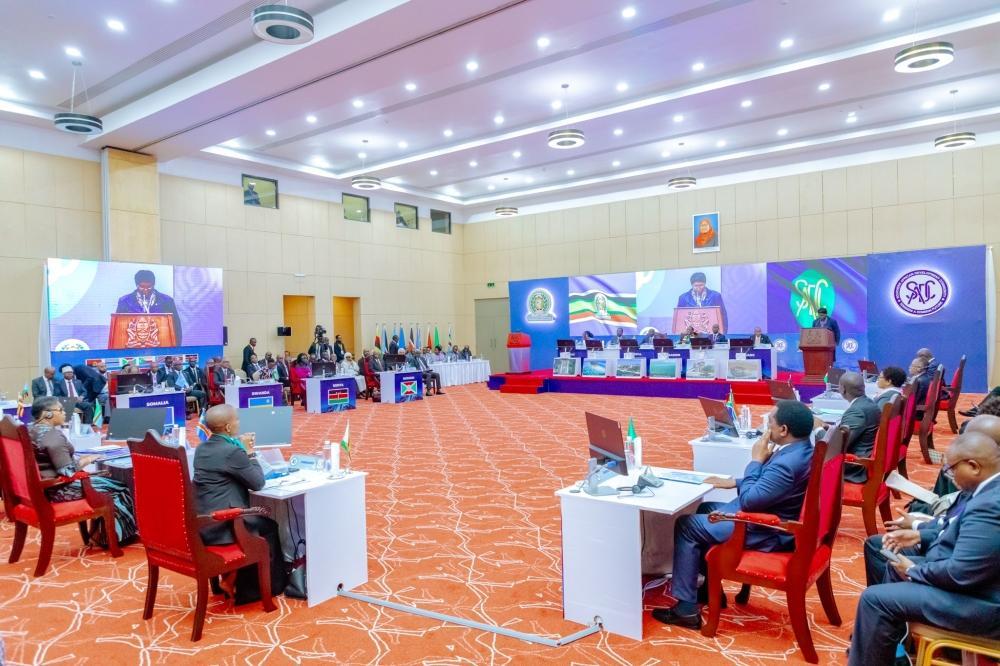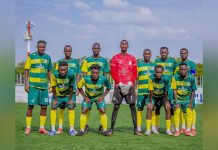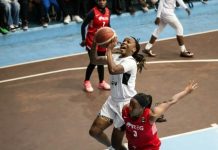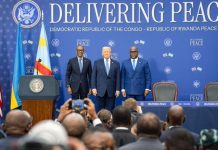Africa-Press – Rwanda. Leaders of the East African Community (EAC) and the South African Development Community (SADC) last week on Saturday approved a new set of measures expected to be crucial in pacifying the conflict-battered eastern DR Congo.
Among the resolutions, summit held in the Tanzanian port city of Dar es Salaam uncluded one compelling the Kinshasa government to directly engage in direct talks with M23, among other armed groups operating in the volatile region.
These negotiations will be held under the ambits of the now merged Luanda and Nairobi processes.
Analysts observe that the summit which brought together both blocs is a major step forward, maintaining that unless all parties to the conflict are brought around the negotiating table, all diplomatic solutions will lack credibility and be unsustainable in the long term.
VIDEO: Corneille Nangaa on capture of Goma, FDLR, and march to Kinshasa
Kinshasa, which is a member of both regional blocs, has previously engaged the two blocs in isolation from each other.
Despite the optimism, however, it remains unclear whether all parties will honor the resolutions, according to analysts who referenced the previous agreements that are yet to yield results.
The summit is the latest sign in a series of attempts to resolve the escalating security situation in the eastern DR Congo.
The New Times compiles a chronology of different peace agreements and accords signed to bring peace to DR Congo since 2000.
Lusaka Ceasefire Agreement (July 10, 1999 – finalized in early 2000)
The Lusaka Agreement between regional countries; Angola, DR Congo, Namibia, Uganda, Rwanda and Zimbabwe, aimed at bringing an end to the hostilities propagated in DR Congo.
The agreement also provided for deploying a UN peacekeeping mission-MONUC, later renamed MONUSCO which has since then maintained presence.
At the time parties were looking to address several issues including the cessation of hostilities, establishment of a joint military commission (JMC) comprising representatives of the belligerents, withdrawal of foreign groups, disarming, demobilising, and reintegrating of combatants.
The UN peacekeeping force was meant to monitor the ceasefire, investigate violations and disarm, demobilise, and facilitate reintegration of armed groups, but was later blamed for “achieving no results.”
It has been over two decades since the deployment, and with over $40 billion in funding to the mission, there is nothing to show for the investment.
Pretoria Agreement (July 30, 2002)
On July 30, 2002, DR Congo and Rwanda signed an Agreement “on the Withdrawal of the Rwandan Troops from the Territory of the Democratic Republic of the Congo and the Dismantling of the ex-FAR and Interahamwe Forces in the Democratic Republic of the Congo,” in Pretoria, South Africa.
Under the agreement, Rwanda said it would withdraw its troops from the territory of DR Congo, and Kinshasa was expected “to assemble and disarm the ex-FAR and Interahamwe in the whole of the territory” of DR Congo.
The Kinshasa regime at the time promised to ensure that its territory did not become “a base for attacks against its neighboring countries.”
Both parties (Rwanda and DR Congo) also agreed that third parties – those that were to facilitate the implementation of this peace agreement – were the UN Secretary-General and South Africa, which was then led by President Thabo Mbeki.
More than 20 years later, the FDLR, a Rwandan militia created by individuals linked to the Genocide against the Tutsi, are now integrated into the Congolese army (FARDC) and fighting alongside them.
The FARDC coalition also includes South African troops who were expected to facilitate the agreement. The troops are fighting alongside Congolese forces (through SAMIDRC) against the AFC/M23 alliance. However, reports indicate that the recent offensive has dealt a huge blow to the FARDC coalition.
Sun City Agreement (April 19, 2002 – finalized in December 2002)
Signed in South Africa after lengthy negotiations, the Sun City Agreement called out the DR Congo to disarm genocidal forces who fled to the Congolese territory after carrying out the 1994 Genocide against the Tutsi.
The remnants of the perpetrators formed the FDLR, which the Congolese government has financed and integrated into its army coalition.
Rwanda has on several occasions made known the threat paused by the FDLR militia due to the group’s sinister plan of destabilising Rwanda. FDLR has also been sanctioned by the UN as a terrorist organisation.
The group has previously launched attacks on Rwandan territory, killing scores of civilians and injuring others before being repulsed and retreating to the Congolese jungles.
The FDLR genocidal ideology is also an existential threat to Congolese Tutsi communities, according to experts.
In South Africa, the Sun City agreement was seen as the solution to the problems besetting eastern DR Congo.
Unfortunately, the agreement was never implemented, according to former South African President Thabo Mbeki.
Goma Peace Agreement (January 23, 2008)
Signed between the Congolese government and 22 armed groups, including the CNDP (National Congress for the Defense of the People) led by Laurent Nkunda, the Goma peace agreement aimed at ending fighting in North and South Kivu provinces.
The deal was reached after Congolese forces suffered a series of stinging defeats at the hands of the rebel movement led by Nkunda.
It also established an amnesty for combatants and a ceasefire. Analysts said that the peace deal was brokered by the US, the United Nations, and the European Union (EU), as part of the efforts to contribute to lasting peace in the DR Congo.
Contracting parties under the agreement at the time said that they were convinced of the necessity to find a quick and lasting solution to this crisis which, for years, had prevailed in the eastern DR Congo.
They also reiterated that they were “aware of the fact that Dialogue is the best way to solve conflicts.”
March 23, 2009 Agreement (March 23, 2009)
Signed between the DRC government and CNDP, the March 23 agreement aimed at reintegrating CNDP fighters into the Congolese army (FARDC).
However, with Kinshasa’s failure to uphold the agreement, some former CNDP members formed the M23 rebel group.
Under the deal, CNDP would become a political party, its forces partially integrated into the FARDC (with the caveat that they would remain under semi-autonomous command structures, and only deployed in the East), and action pledged on several long-standing grievances propagated towards the Kinyarwanda-speaking Congolese populations.
Again, the Kinshasa regime reneged on this agreement, which resulted M23 movement.
Addis Ababa Peace, Security, and Cooperation Framework (February 24, 2013)
Signed by 11 African countries and endorsed by the United Nations, AU, SADC, and ICGLR, the peace deal aimed to address the root causes of the DR Congo conflict and at the same time prevent external interference.
The signing ceremony took place in the new Conference Centre of the African Union (AU) Headquarters, in the presence of several African and international dignitaries.
The agreement was signed by the DR Congo, Angola, the Republic of Congo, South Africa, Tanzania, Uganda, the Central African Republic (CAR), Burundi, Rwanda, South Sudan, and Zambia.
Among other factors, the framework called for ending the conflict in the area, and creating long-term peace and stability in the region.
Nairobi Declarations (December 12, 2013)
The DR Congo government and the M23 rebel movement signed declarations on 12 December formalizing agreements to end hostilities in the eastern part of the country.
The declarations, together with a Final Communique on the Kampala Dialogue, were released by the International Conference on the Great Lakes Region (ICGLR) and the Southern African Development Community – which together facilitated almost a year of fitful peace talks in the Ugandan capital.
Both parties articulated commitments on a range of issues, including M23’s renunciation of rebellion and transformation into a political party; the government’s limited offer of amnesty to combatants; the release of prisoners; the demobilization and reintegration of former rebels; national reconciliation and justice; and social security and economic reforms.
At the time, Kinshasa also committed itself to quickly moving ahead to facilitate the return of refugees, in line with tripartite agreements signed with neighboring states, and to help internally displaced civilians, who number more than two million in eastern DRC, go back home.
Kinshasa also failed to honor the agreement.
Luanda and Nairobi Peace Processes (2022–2023)
The recent peace processes have allowed for a series of back-to-back summits and agreements involving the EAC, Angola, and other regional actors to address the ongoing M23 resurgence and conflicts in eastern DRC.
Launched in April 2022, the peace talks (which have since stalled) are based on principles of inclusivity, dialogue, ownership, regional leadership, and international support.
This process seeks to engage all stakeholders, including the DRC government, armed groups, civil society organizations, and the international community in finding a peaceful resolution to the conflict through dialogue and negotiation.
When the M23 resurfaced in 2021, the East African Community Regional Force (EACRF) was deployed in November 2022 to help facilitate the implementation of the Nairobi process. Among its task was to occupy areas that were vacated by M23 rebels, when they agreed to retreat to give peace a chance.
However, soon after they arrived, Tshisekedi ordered them to engage in combat with M23 rebels, which was not part of their rules of engagement, because they had been deployed to facilitate a peace process.
A key highlight of this was when, during a Heads of State summit in Bujumbura in February 2023, Tshisekedi confronted Maj Gen. Jeff Nyagah, the Kenyan officer who was the first force commander of EACFR, and in a televised outburst, he accused him of “being part of the problem.”
Later he ordered for the force’s withdrawal from DR Congo because they refused to do his bidding.
He then ditched EAC and courted Southern African Development Community (SADC), to which DR Congo is also a member, to send him troops to help him fight M23, in complete disregard of the Nairobi Process.
SADC deployed a force named SAMDRC which has been fighting alongside FARDC, European mercenaries and armed militia groups including FDLR, in the fight against M23, but with little success on the frontline.
It now remains to be seen if Kinshasa will adhere to the resolutions made in Dar es Salaam.
For More News And Analysis About Rwanda Follow Africa-Press






